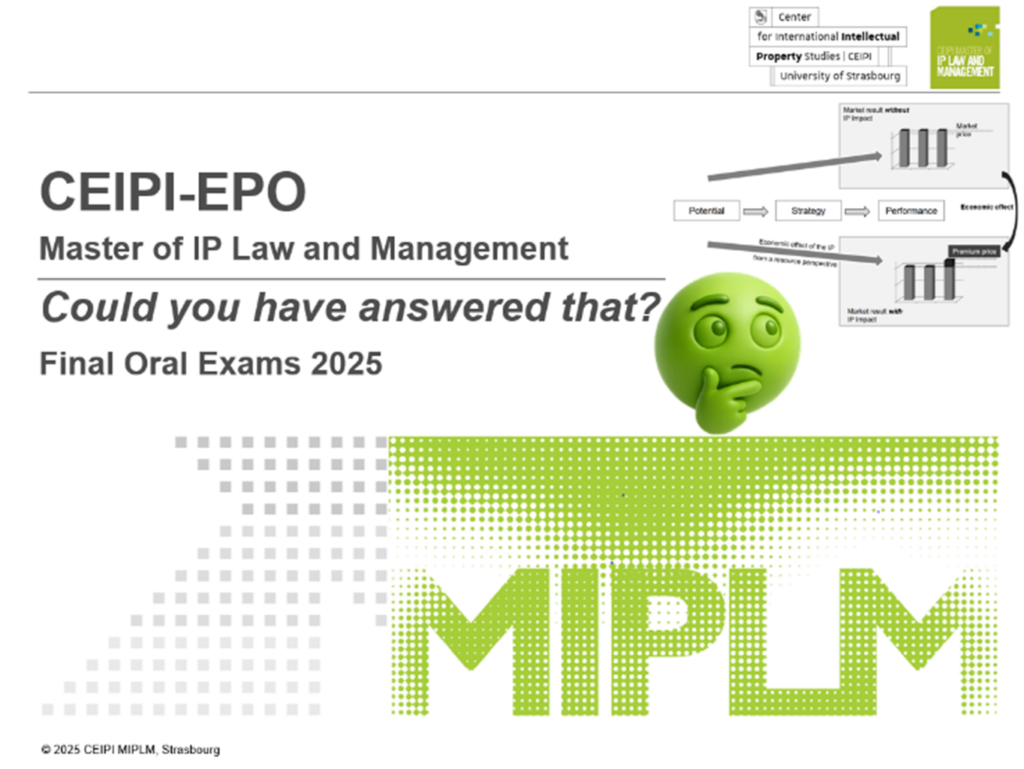Could You Have Answered That? Cracking the CEIPI-EPO MIPLM’25 Exam on IP Licensing
Licensing transforms IP from a legal asset into a strategic business tool. Task 13 of the CEIPI-EPO MIPLM’25 exam challenges candidates to explain how IP generates economic value. Using AutoPlus S.E. as a case, this post shows how licensing—combined with compliance monitoring—creates sustainable revenue and competitive advantage. It highlights insights from CEIPI lectures and IP experts, emphasizing licensing as a process, not just a deal.
The Exam Question
In Task 13 of the 2025 CEIPI-EPO MIPLM oral exam, candidates were presented with a challenge central to today’s innovation-driven economy:
“AutoPlus S.E., a Swiss manufacturer of electronic components in the automotive sector, wants to critically evaluate the economic benefit and value of their patent portfolio. They ask you to explain the economic characteristics of IP, the value constitution of IP assets, and to present licensing as a value exploitation tool.”
This task doesn’t just test knowledge of IP law or strategy—it probes the candidate’s ability to connect IP management with business outcomes. The focus is on turning IP from a legal asset into a strategic business lever.
What the Lecture Teaches: IP Strategy and Exploitation
The CEIPI Module M1 lecture on “IP Strategy Development” lays the foundation for understanding how IP generates value within strategic management frameworks. The key takeaways from the lecture slides and exercises include:
1 . IP as a Strategic Resource
IP is a non-rivalrous asset with scalability in exploitation. It incurs sunk costs in creation but has inverse value development—the more it’s used strategically (e.g., licensed), the higher its realized value. IP creates competitive advantages when integrated with complementary assets like production capabilities, skilled personnel, and customer access.
2 . Value Constitution of IP Assets
According to the lecture, IP becomes economically meaningful when:
-
-
- It reflects a protected innovation (value potential)
- It is integrated with complementary resources (value realization)
- It is exploited via a business model (value extraction)
-
3 . Licensing as an Exploitation Strategy
Licensing transforms IP into cash flow. It enables companies to:
-
-
- Monetize unused IP
- Enter markets with low operational risk
- Form strategic alliances
- Influence standards or maintain ecosystem control
-
Crucially, licensing doesn’t only mean “selling rights”—it’s about structuring relationships, setting incentives, and allocating control in innovation ecosystems.
Learning from the Platform: Insights by IP Subject Matter Experts
On the IP Business Academy platform, multiple IP subject matter experts share practical content directly linked to this topic. For example:
- Tomas Geerkens: Controlling License Contract Compliance
- Bas Albers: IP Strategies for SME
- Oliver Baldus: Lean IP
- Bernd Bösherz: Industry Acumen for Patent Attorneys
- Alihan Kaya: Green Technologies and Patents
Learners can find deep dives, articles, and even webinars on:
- Glossary Entry: IP Licensing Compliance Audit
- Glossary Entry: Licensing
- Layered IP Strategy
- Unique Selling Proposition (USP)
- A Comprehensive Guide to IP Licensing
- Licensing-Based Business Models
Sample Solution: IP Licensing as a Tool for Value Creation at AutoPlus S.E.
Company Context
AutoPlus S.E. holds 76 EP patent families but lacks a clear exploitation strategy. They’re a tier-2 automotive supplier in a sector shifting toward electrification, software integration, and data-driven service models.
Step 1: Economic Characteristics of IP
- Non-rivalry: Multiple licensees can use the same IP without diminishing its value.
- Scalability: A single patent can underpin several revenue streams.
- Sunk costs: Patent filing and prosecution are upfront investments, independent of usage.
- Value inversion: The more a patent is integrated into value chains, the more it pays off.
Step 2: Value Constitution
To turn patents into economic value, AutoPlus needs:
- A viable licensing model (e.g. royalty-based, field-of-use, cross-licensing)
- Complementary assets such as data ownership, know-how, or manufacturing capabilities
- Control mechanisms via contractual terms, audits, and compliance monitoring
Step 3: Licensing as Exploitation Strategy
AutoPlus can deploy licensing in three main directions:
- Outbound licensing: Licensing out its sensor technologies to non-competing adjacent sectors (e.g., agriculture or health tech)
- Joint development licensing: Sharing IP in co-innovation projects with OEMs or Tier-1s while retaining partial rights
- Platform licensing: Offering their technology as a module in a broader system, integrating into larger platforms (e.g., battery management ecosystems)
Each scenario requires tailored contractual and monitoring mechanisms to secure revenue, ensure compliance, and prevent leakage of confidential know-how.
Step 4: Licensing Compliance Monitoring
An essential yet often overlooked element is license compliance. Without enforcement and audit rights, licensees may underreport royalties or misuse IP. Licensing compliance is especially crucial in the automotive sector where:
- Embedded software and multi-tier supply chains obscure usage
- Cost pressure incentivizes non-compliance
- Software updates and digital twins increase complexity
Thus, licensing must be treated not as a “deal”, but as a process—monitored over time through robust governance.
Why Licensing Compliance Is a Critical Part of Sustainable IP Strategy
A licensing strategy without compliance control is like a payment system without accounting. As AutoPlus aims to build a sustainable business model around its innovations, the company must:
- Establish licensing KPIs (e.g., revenue per patent family, audit frequency)
- Include digital rights management for software-related inventions
- Integrate audit clauses, usage tracking, and escalation paths in all agreements
- Use compliance software where possible to automate monitoring
Failing to do so doesn’t just result in lost income—it damages the IP’s perceived value and weakens future negotiation power.
Final Thought: Licensing as Value Lever in the Automotive Sector
In the transformation of the automotive sector—where technologies are increasingly software-driven, platform-based, and subject to regulatory scrutiny—IP licensing is more than monetization. It is a strategic tool to:
- Shape ecosystems
- Leverage underused assets
- Create entry barriers
- Build influence without direct market presence
AutoPlus S.E. stands at the threshold of this transformation. By understanding and managing the economics of their IP portfolio and embedding licensing into their business model—with a clear focus on compliance—they can convert static IP into a dynamic engine of value creation.



